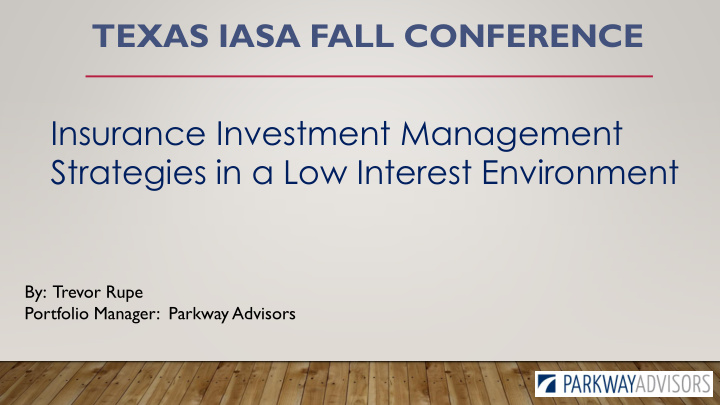



TEXAS IASA FALL CONFERENCE Insurance Investment Management Strategies in a Low Interest Environment By: Trevor Rupe Portfolio Manager: Parkway Advisors
▪ Unique Characteristics of an Insurance Company ▪ Performance Objectives for an Insurance Company ▪ Types of Investment Risk ▪ Key Insurance Specific Investment Risks ▪ The Current Market ▪ Low Interest Rate Investment Strategies ▪ Combining It all Together ▪ Questions
▪ Asset Management Requires Specific Knowledge and Tools ▪ Accounting for an Insurer is Extremely Unique ▪ Regulation is Unique ▪ Design is Unique ▪ Employee Positions are Unique
▪ Assets are there to Support the Future Claims of the Company ▪ Surplus Focus ▪ Risk Based Capital (RBC) ▪ NAIC and State Insurance Code is Focused on Cash Flow ▪ Policyholder Focus ▪ Required Annual Cash Flow Testing For Most Insurance Types ▪ NAIC and State Insurance Code is Focused on Surplus Volatility ▪ Restrictions on Assets that Increase Surplus Volatility ▪ Higher RBC and AVR (Life Insurers) Factors on Certain Assets ▪ Statutory Accounting is Focused on Cash Flow ▪ Carrying Bases As Amortized Cost ▪ IMR for Life Companies
Performance Objectives for an Insurer ▪ There are Many Performance Concerns for an Insurer ▪ Enhancements to RBC ▪ Increased Surplus ▪ Book Yield ▪ Current Yield ▪ Net Investment Income ▪ Total Return ▪ Performance Objectives Differ for Each Insurance Company
▪ A Focus on Net Investment Income Above Total Return is Key ▪ Book Yield Translates Most Closely to Net Investment Income ▪ A Primary Focus on Total Return can Significantly Damage: ▪ RBC ▪ IMR/AVR (for Life Companies) ▪ Cash Flow Testing ▪ Net Investment Income due to Statutory Accounting ▪ Not in line with Reducing Insurance Company Specific Risk ▪ Performance Objectives should be Constrained by Risk Levels
Types of Investment Risk ▪ There are Many Investment Risks ▪ Diversification Risk ▪ ALM Risk ▪ Credit Risk ▪ Opportunity Risk ▪ Impact Risk ▪ Interest Rate Risk ▪ Liquidity Risk ▪ Perception Risk
▪ Diversification Risk ▪ The Relationship of the Assets to the Insurance Products (ALM)
Key Investment Risk - Diversification ▪ Diversification is Often Applied Incorrectly for Insurance Companies ▪ Modern Portfolio Theory ▪ Consider Accounting Principles in Diversification Policies ▪ Primary Reason Insurers Lost Surplus During the Financial Crisis ▪ Diversification Should Consider Surplus ▪ Diversification Should Consider AVR ▪ Future Regulation Changes to RBC
Insurance Assets Build Long-Term Surplus If ▪ ▪ Products Priced Effectively ▪ Assets Remain on the Books the Length of the Insurance Products An Immunized Portfolio (Asset Cash Flows Provide for Liability Cash Flows) ▪ ▪ Mitigates Market Risk ▪ Mitigates Reinvestment Risk Improper ALM is the Primary Reason Insurers are Underperforming ▪ Currently
Asset Cash Flow in Comparison to the Liability Cash Flow Base Case (Stable Interest Rates) $7,000,000 $6,000,000 $5,000,000 $4,000,000 $3,000,000 $2,000,000 $1,000,000 $- 2019 2020 2021 2022 2023 2024 2025 2026 2027 2028 2029 2030 2031 2032 2033 2034 2035 Liabilities Cash Flow Portfolio Cash Flows
Asset Cash Flow in Comparison to the Liability Cash Flow Reinvestment Risk $10,000,000 $9,000,000 $8,000,000 $7,000,000 $6,000,000 $5,000,000 $4,000,000 $3,000,000 $2,000,000 $1,000,000 $- 2019 2020 2021 2022 2023 2024 2025 2026 2027 2028 2029 2030 2031 2032 2033 2034 2035 Liabilities Cash Flow Portfolio Cash Flows
Asset Cash Flow in Comparison to the Liability Cash Flow Market Risk $7,000,000 $6,000,000 $5,000,000 $4,000,000 $3,000,000 $2,000,000 $1,000,000 $- 2019 2020 2021 2022 2023 2024 2025 2026 2027 2028 2029 2030 2031 2032 2033 2034 2035 Liabilities Cash Flow Portfolio Cash Flows
10 Year US Treasury Under 2% ▪ 10 Year US Treasury at 1.458% in September ▪ 80 basis points differential between 2 and 10 Year A1 Corporate Bonds ▪ 3 Interest Rate Cuts in 2019 ▪ Curve went Inverted in 2019 ▪
▪ Duration/Maturity Extension to Achieve a Higher Book Yield ▪ Movement into other Asset Classes (Real Estate, Mortgages) ▪ Reduction in Credit Quality
Opportunity to fill ALM Mismatch that Developed on the Short to Medium Part of the Curve Asset Cash Flow in Comparison to the Liability Cash Flow Typical Observed Trend $7,000,000 $6,000,000 $5,000,000 $4,000,000 $3,000,000 $2,000,000 $1,000,000 $- 2019 2020 2021 2022 2023 2024 2025 2026 2027 2028 2029 2030 2031 2032 2033 2034 2035 Liabilities Cash Flow Portfolio Cash Flows
Credit Clean Up Opportunity ▪ Consider Removal of Lower Credit and Watch List Items ▪ Opportunity to offset losses through IMR due to Imbedded Gains ▪ Imbedded gains allow for Partial Liquidations ▪ Reinvestment in New Names for Diversification ▪ Risk Reduction considering Surplus and Exposure Concentration ▪ Positive Impacts to RBC ▪
Investment Transactions can Achieve Multiple Objectives ▪ ▪ Portions of Securities can be Sold in Areas of Excess Cash Flow ▪ Reinvestment can Occur in Areas of Need with New Names The Impact to the Statutory Financials Must be Considered ▪ ▪ Book Yield Changes on the Transaction are Important to Know ▪ RBC, IMR/AVR, Net Income, and Book Value are Quantified ▪ Preparation of Schedule D and IMR/AVR on a Before and After Basis Performance Should be Measured ▪ ▪ Book Yield ▪ Net Investment Income ▪ A Good Total Return can be Achieved with a Book Yield Focus
Trevor Rupe Trevor.rupe@parkwayadvisors.com (325) 795-2111
Recommend
More recommend